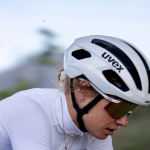In looking to fulfill his vision of seeing Saucony become “the next great global athletic brand,” Richie Woodworth, the running brand's president, pointed out that Saucony had to do a better job attracting men.
Speaking at the Annual Institutional Investor Conference for the brand's parent, Collective Brands International, Inc., Woodworth said the new focus came after Saucony found it was noticeably over-indexed in women and under-indexed in men. “We said, 'Okay, if the marketplace is 62% men, 38% women, what are we?' Boom, we're exactly the inverse opposite,” said Woodworth. The challenge, however, was attracting more men to the brand without alienating its “extremely loyal” women consumer.
Tapping consumer insight research, Saucony learned it had to do a better job reaching the young male runner, in particular the young sprinter over the long-distance runner. Saucony determined that the 16-20 year old sprinter is typically a running back on the football team in the fall and a sprinter in the spring. “So he's the stud in the school, right?,” said Woodworth. “Running back, he's got the varsity letter. But in the spring, he runs the 100 and he's still the stud on the track.”
Converting this athlete to Saucony would not only give the brand authenticity and credibility but Woodworth feels they also going to give the rest of the kids in that school permission because that athlete is “kind of the top of the pyramid guy,” according to Woodworth.
That gave Saucony's designers the impetus to create what they saw as the best track & field shoe on the market. But it was particularly important to get the brand in the sporting goods channel where the running back buys his cleats and equipment, Woodworth noted. As such, the line will be sold to Dick's Sporting Goods and supported next year by a Spikes Nights campaign at the chain.
But Woodworth also pointed to numerous other strategies to grow the brand.
First, although Saucony gained almost two-percentage share in run specialty alone last year, “We need conversion. We've got some ways that we're going to convert people from Asics into our shoes,” suggested Woodworth. As such, promotions are being planned to get runners to try Saucony.
Another major growth area is the sporting goods channel, which the exec referred to as “probably the biggest kind of growth potential for us in an immediate basis.”
Saucony also plans to develop a “meaningful apparel business,” and sees sales tripling in the near term on a small base. The Saucony apparel brand was launched in 2008 after the Hind brand was discontinued. Woodworth also noted that getting the brand name on a bag or sweatshirts “really helps obviously elevate our brand in ways that we can't do with just footwear.”
Internationally, Europe will be a focus with aligned strategies setup in Germany, Benelux and the U.K.
While he didn't elaborate, Woodworth also saw an opportunity to target males with the Originals retro line.
E-commerce is being launched for the first time by Saucony this fall and the brand also continues to reach its fan base through social networking activities such as expos and races. Saucony also has a mobile van attending events that biomechanically fits runners and is also working with retailers on fit programs.
Saucony also last year shifted from using multiple factories and created the Saucony Development Center in China to drive innovation. Said Woodworth, “Technology doesn't always have to come from in your kitchen or in your back design room. It can come from a lot of different places and one of those is through our unique partnership with our factory in China.”
Woodworth said the Saucony brand has been growing at double-digit rates over the last few years — including adding $23 million in 2008 — and is now a top three running brand. But Woodworth sees the momentum continuing.
Also speaking at the presentation, Kristin Burrows, president of Keds, said part of her efforts in turning around Keds is re-launching the Keds' website in October. Indeed, the majority of the brand's marketing funds for 2009 was redirected towards the website redesign.
“Why?,” said Burrows, who took over Keds about a year ago. “Because this is where our consumer lives and breathes. This is a very digitally-focused consumer.”
The website will also include Keds Collective, a group of artists, fashion designers and graphics designers to serve as ambassadors for the brand.
“They're actually going to be participating in the design of the brand and the product through our online customization tool and we'll be celebrating them and highlighting them as part of our brand message,” said Burrows. “This is something no other branded entity is doing today.”
Other moves for Keds was bringing the men's Pro-Keds positioning closer to Keds' to drive “one primary message” across both brands. In women's, Keds is focusing on the Champion, the original sneaker since 1916, to capitalize on its canvas roots. Another focus will be on collaborations such as the launch of a collection at Barneys in partnership with Loomstate, a design house specializing on organic materials. Gaining floor space at places like Barneys and Jeffries through collaborations also increases access to stores like Journeys and Nordstrom. But Burrows said the main focus will be focused on engaging Millenials.
“It's about conversing with the consumer, enrolling them in the development of your brand,” she suggested.















